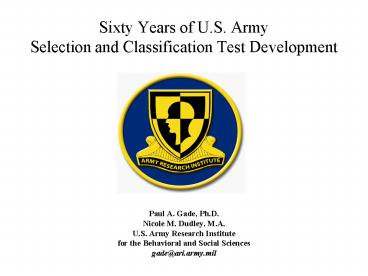Sixty Years of U.S. Army Selection and Classification Test Development - PowerPoint PPT Presentation
1 / 7
Title:
Sixty Years of U.S. Army Selection and Classification Test Development
Description:
During WWII, the AGCT was used successfully to classify more ... Congress issued Joint-Service Job Performance Measurement/Enlistment Standard (JPM) mandate. ... – PowerPoint PPT presentation
Number of Views:133
Avg rating:3.0/5.0
Title: Sixty Years of U.S. Army Selection and Classification Test Development
1
Sixty Years of U.S. Army Selection and
Classification Test Development
- Paul A. Gade, Ph.D.
- Nicole M. Dudley, M.A.
- U.S. Army Research Institute
- for the Behavioral and Social Sciences
- gade_at_ari.army.mil
2
Selection and Classification WWII through the
Vietnam War
- 1940 - Army General Classification Test (AGCT).
- During WWII, the AGCT was used successfully to
classify more than 12,000,000 soldiers and
marines for specialty and officer training. - 1940s - Army Aptitude Area System for
differential classification - Began efforts to determine the combinations of
valid tests for different Army Military
Occupational Specialties (MOS) organization of
specific aptitude tests into Army Aptitude Area
System for differential classification was major
innovation for military personnel system. - 1950 - Armed Forces Qualification Test (AFQT).
- 1st selection instrument to be used for the
uniform mental screening of recruits and
inductees across the services. - Used to determine mental qualifications of
recruits during the Korean and Vietnam Wars. - Currently used as general screening score by the
Army and the other Services.
3
Selection and Classification The All-Volunteer
Force (AVF), Project A, Career Force
- 1976 - Armed Services Vocational Aptitude Battery
(ASVAB) following transition to AVF. - Joint Service test used from 1976 to now as
primary tool for classifying soldiers. - 1976-1980 - Inadvertent misnorming of ASVAB
- Congress issued Joint-Service Job Performance
Measurement/Enlistment Standard (JPM) mandate. - 1982-1995 - Project A Career Force
- Project A went well beyond mandate to validate
ASVAB. - Validation of ASVAB to predict job performance
as well as validation of various new predictors
(e.g., personality). Birth of classic prediction
model. - Identified five core dimensions of job
performance Can Do technical, job
proficiency, general soldiering proficiency, and
Will Do effort and leadership, personal
discipline, and physical fitness bearing . - Measured more than 60,000 soldiers in 21
Military Occupational Specialty (MOS), included
concurrent and longitudinal validation samples.
4
Selection and Classification Project B and the
Enlisted Personnel Allocation System (EPAS)
- Early work by Hubert Brogden on differential
assignment theory set stage for Project B and its
successor, EPAS. - 1982- Project B
- Initiated at same time as Project A
- Goal to develop computerized job assignment
system that would optimize initial job
assignments to put most qualified applicants in
Army jobs likely available for the next year. - Enlisted Personnel Allocation System (EPAS)
- Uses goal programming that incorporates Aptitude
Area scores, projected training set availability,
and projected availability of applicants to make
near optimal job assignments. - Research since late 1980s demonstrates that
EPAS can indeed enhance assignment optimization
for an annual recruit cohort, given Army
enlistment requirements.
5
Selection and Classification Recruiter Selection
- 1982 Recruiter assessment center developed
- Originally developed to help select recruiters
prior to training in the Army Recruiter Course. - Turned into recruiter development center to
provide untrained recruiters with diagnostic
preview of tasks would do in the Army Recruiter
Course to help new recruiters adjust to the job
and to maximize training benefits. - Perhaps the first use of assessment center as a
training diagnostic.
6
Selection and Classification Computerized
Adaptive Testing (CAT)
- Forerunners of adaptive testing
- Abraham Bayroffs early work on branching tests
largely unrecognized until work of Jim McBride at
ARI on adaptive mental testing. - Navy Personnel Research and Development Center
(NPRDC) ARI pioneers - NPRDC developed CAT-ASVAB which paved way for
practical application of adaptive testing and
Item Response Theory (IRT) - Computerized Adaptive Screening Test (CAST)
- First widespread practical application of CAT.
- Developed for ARI by NPRDC based on items and
testing strategies from early CAT-ASVAB work. - CAST used in Army recruiting stations to screen
applicants. - CAST provide quick, valid estimator of AFQT
portion of ASVAB. - Also gave recruiting advertisers new way to
assess effectiveness of advertising targeted to
population likely to be eligible for military
service.
7
Selection and Classification New Directions
- Future-oriented selection (e.g., Select21, NCO21)
- Performance measurement (e.g., Perform M21)
- Zeidner and colleagues work on differential
classification - Development of a faking-resistant temperament
measure, the Assessment of Individual Motivation
(AIM Young Whites research) - Robert Sternbergs triarchic theory of successful
intelligence - Tacit Knowledge of Military Leaders (TKML)
Inventory. TKML measures practical, largely
unarticulated, procedural knowledge about
leadership, different from g, experience, and
personality. - Early success demonstrated using tacit knowledge
in training programs to accelerate leader
development process. Now looking at measuring
adaptability and flexibility via creative
intelligence. - Emotional intelligence measurement (potential
classification device) - Peter Legrees work on the properties and utility
of consensus based measurement in situational
judgment tests. - Conditional reasoning methodology (potential
selection tool)































